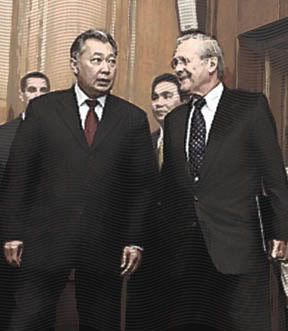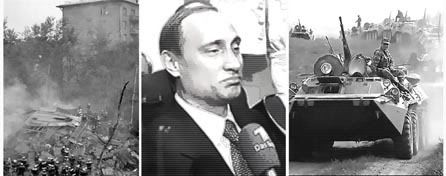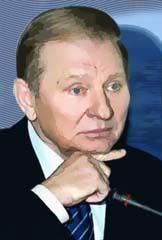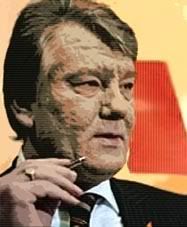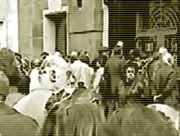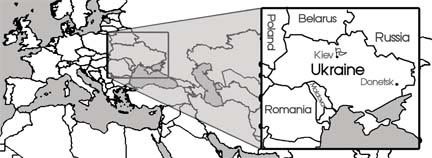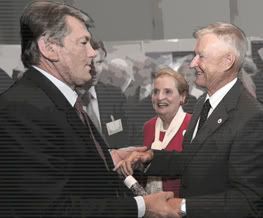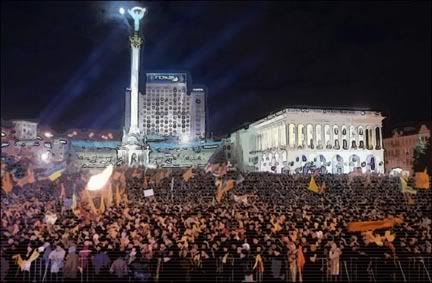THE LIMITS OF NON-VIOLENCE
ADAM LARSON
CAUSTIC LOGIC / GUERILLAS WITHOUT GUNS
Posted 2/27/07American support like that offered in Serbia was not universally supported – there were exceptions. In Africa, for example, Zimbabwe was in its own turmoil at the same time; strongman Robert Mugabe had spawned his own opposition, the leaders of which were inspired by other revolutionary struggles around the world. They immediately acted after seeing the dramatic success of Otpor in Belgrade. Laura Rozen wrtote for
Salon in February 2001:
“Hours after Milosevic fell in October, anti-government protests swept through Zimbabwe as parliamentary elections approached. Opposition leader Morgan Tsvangirai vowed to stop ‘Africa's Milosevic.’ “Mugabe has committed genocide against a minority, rigged elections, ignored the rule of law, and created a state which is internationally isolated," Tsvangirai said Oct. 6, just as Milosevic was conceding defeat in Belgrade. “We have given Mugabe a warning. A similar situation to Yugoslavia cannot be avoided.” [1]
But of course such a thing could be avoided and was. Nothing like the Bulldozer Revolution happened in Zimbabwe at that time. There are opposition leaders on the scene, Tsvangirai foremost among them, and by early 2005 he was finally receiving help from Colonel Helvey and others, according to the
Christian Science Monitor. [2] But the public has not rallied behind the opposition to a large enough degree and as of mid-2006 Mugabe is still in power.
This citizen “apathy” has been blamed on many factors, but two that Helvey pointed out as key obstacles were hunger and AIDS. “When people are starving, it's awfully hard to promote democracy,” he explained. Roughly 40% of the nation’s 12 million people are near starvation, according to a recent report. In such circumstances, “you can't have 1 million people sitting in the streets of the capital for 17 days,” Helvey elaborated. “There's not going to be food for them.” Then there's AIDS. In 2002, the official HIV infection rate was 27 percent, one of the world's highest and thought to have gone up since then. Helvey wondered in such a climate, “who's got the energy to protest?” [3] Thus it seems Helvey’s tactic falls flat in places like Zimbabwe, where reforms are most urgently needed.
But perhaps the apathy regarding reform there lies elsewhere. It could be that Zimbabwe simply offered too few riches to be seen as worthwhile in Washington. This possibility indicates one key moral weakness of the strategy – while promising to remove a reviled dictator without resort to violent war, like war it tends to work only where the US is looking to invest; no type of conflict is waged if a target nation hasn’t enough to offer.
However, and for other reasons, Sharp’s nonviolent conflict also got no real support against Saddam Hussein in Iraq which clearly does have massive resources – primarily one of the world’s largest supplies of petroleum in an age of shrinking supplies. The U.S. was already in a state of war against a reviled dictator there; after the fierce bombardment of its infrastructure in 1991, Iraq continued to marinade in economic sanctions through the Clinton years, punctuated with occasional air strikes whenever Saddam was perceived as trying to sneak out of his “box.” No fly zones enforced by the U.S. ostensibly to protect Kurds in the North and Shiites in the South left most of Iraq beyond Baghdad’s effective control. Iraq was thus progressively weakened; even as Saddam himself retained his elaborate network of grandiose palaces, the nation’s people were wracked with malnutrition, water-borne disease, and epidemic deformities possibly caused by US-deposited Depleted Uranium munitions. On top of this the sanctions and inadequate oil-for-food program held fast. Madeleine Albright even told 60 Minutes in 1996 (she was UN Ambassador at the time, soon-to-be Secretary of State) that the reported 500,000 children who had died from the sanctions were “worth it,” although it was a “hard” calculation. (She later explained that she regretted making this admission and should instead have deflected the question by blaming the peoples’ suffering on Saddam, as was standard.) [4]
The sanctions regime thus dragged on into the twilight of the Clinton years as the Serbian situation unfolded. But one way or another it was set to change. It was the re-emerging superpower rival Russia that started leading the charge to end sanctions and bring Iraq, even with Saddam Hussein in charge, back into the mainstream oil economy. Foreign Minister Igor Ivanov explained to UN Secretary General Kofi Annan in mid-2000 that the Russian government was “in favor of mitigating the limitations imposed on Russia by the sanctions.” This position was supported by French president Jaques Chirac, who further called the sanctions “dangerous, inhumane, and inappropriate.” [5] The London
Financial Times reported on September 12 2000 “the Russian and French positions are giving Iraq hope that the sanctions, if not lifted, will soon become meaningless.” Deputy prime minister Tariq Aziz explained in an interview with the magazine “Iraq's practically becoming more like Cuba vis a vis the US. […] Everyone else is trading with Cuba, this is going to be the future of the matter.” [6]
A different course to ending sanctions was coalescing in the US, crafted by neoconservative Republican power hopefuls as part of a plan to preserve “the global Pax Americana.” The Project for the New American Century (PNAC), the by-now infamous think tank featuring names like Cheney, Rumsfeld, Wolfowitz, Perle and Woolsey, had formed in 1997 to promote a strong, bold, well-funded military and unapologetic globe-molding neo-imperialism informed by “American values” and “American interests.” The PNAC’s guiding document for making the 21st century a New American one was its September 2000 report
Rebuilding America’s Defenses. The report took a belligerent tone towards Iraq, outlined along with Iran and North Korea (soon Bush’s “axis of evil”) as the three biggest troublemakers in the global system. Russia and China were listed as competitors to contain. Tensions with Russia, China and France would lead to deadlock in the UN Security Council, specifically over Iraq, so the report focused on willingness to take unilateral action or rely on ad-hoc coalitions.
The described high-tech high-cost military “process of transformation,” and its geopolitical aims including in Iraq, would be difficult to achieve, the report noted, without the realization of “a catastrophic and catalyzing event, like a new Pearl harbor.” This report was released and utterly ignored in September 2000, a year before that precise event was delivered and just months before a large PNAC contingent took the reins of power along with George W Bush in the deeply troubling 2000 Election. Among the signatories of that report were Paul Wolfowitz, who would be Deputy Defense Secretary, no. 2 to fellow PNACer Rumsfeld, and Scooter Libby, who would be Chief of Staff to fellow PNACer Cheney; that is, the top aides the top PNACER’s at both the Pentagon and White House.
The dust had just settled in Serbia after the bulldozer revolution when Bush was sworn-in. For the next eight months, as widely noted, Bush’s foreign policy just sort of drifted about amid growing domestic problems – to much of the world this seemed a lull, as if they were waiting for something to show them the way. After the September 11 attacks and the announcement of a worldwide “War on Terror,”
Rebuilding America’s Defenses was for all intents and purposes adopted by the administration as the master strategy for the new generational struggle. Defense secretary Rumsfeld and his team got their direction, coordinating with Cheney at the White House, and began pushing events towards Iraq. Bush delivered a speech at the wounded Pentagon on October 11, 2001, announcing his firm dedication to the PNAC vision, and that 9/11 was indeed the fulfillment of their “new Pearl Harbor” prophecy. In response to the report’s call for increased Pentagon budgets, Bush assured them “in the missions ahead for the military, you will have everything you need, every resource, every weapon, every means to assure full victory for the United States and the cause of freedom.” [7]
But when it came to Iraq, this did not include the Sharp-Helvey nonviolent “post-military weapons system” so recently proven in Serbia. The PNAC had in 1999 targeted Milosevic for downfall and urged Clinton and Congress to take the actions they finally did. [8] One would think they’d be aware of and pleased with Colonel Helvey’s work with Otpor, which had finished the job. Likewise, the PNAC had their sights set on Saddam Hussein, but of course, there was no such utopian revolution in Baghdad, only war and occupation.
The PNAC’s 2000 report said the US had long wanted a “more permanent role in Gulf regional security,” backed up by a “substantial American force presence” in the region, a need which they emphasized “transcends the issue of the regime of Saddam Hussein.” [9] Such a military presence was then extant but threatened in Saudi Arabia; in August 2001 Crown Prince Abdullah in fact quietly and informally requested US forces to leave so he could avoid “the fate of the Shah of Iran.” [10] To get a new force presence, an internal revolution was not what was needed. It was not Otpor and their revolution that left NATO troops in Yugoslavia after all, but the earlier military conflict. And after more than a decade of brutal sanctions and bombs, it was unlikely that any internally produced new regime in Iraq would invite American basing there if given the choice. So the force presence would have to be hammered in, which seems to have been the plan from step one.
Next: Zayer and Helvey: No to Saddam, No to War
Sources:
[1] Rozen, Laura. “Dictator downturn: It just isn't as easy being a tyrant as it used to be.” Salon. February 3 2001 http://archive.salon.com/news/feature/2001/02/03/dictators/print.html
[2], [3] McLaughlin, Abraham. “In Zimbabwe, people power fails to ignite.” Christian Science Monitor
from the March 22, 2005 edition Accessed June 12, 2006.
http://www.csmonitor.com/2005/0322/p01s04-woaf.html
[4] Richman, Sheldon. “Albright Aplogizes.” The Future of Freedom Foundation. November 7 2003. http://www.fff.org/comment/com0311c.asp
[5], [6] Hoyos, Carola. “Russia in New Push to Lift Iraq Sanctions.” Finanacial Times. September 12 2000.
http://www.globalpolicy.org/security/sanction/iraq1/council/russ0009.htm
[7] President George W. Bush's Pentagon Memorial Speech. October 11, 2001 Copied October 19, 2004 from: http://www.september11news.com/PresidentBushPentagon.htm
[8] “Mr. President, Milosevic is the Problem.” Project for a New American Century, International Crisis Group, Balkan Action Council, and Coalition for International Justice. Open letter to the President of the United States. September 20, 1998.
[9] Project for a New American Century Rebuilding America’s Defenses September 2000 Page 14.
[10] Pipes, Daniel “The Scandal of U.S.-Saudi Relations.” The National Interest. Winter 2002/03 http://www.danielpipes.org/article/995

